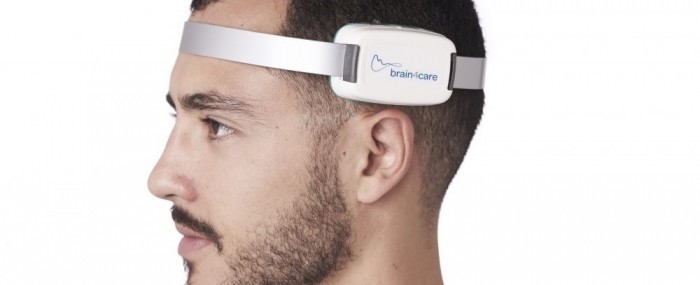
Brazilian healthtech firm makes leap in internationalization plan to reach 1 billion people
02 de março de 2020By Eduardo Geraque | FAPESP Innovative R&D – Brain4care, a Brazilian healthtech firm, has won approval from the US Food and Drug Administration (FDA) for an intracranial pressure sensor it has been developing and refining for 15 years.
The firm is now poised to build its market share in the US and achieve its goal of reaching 1 billion people worldwide with the technology within five years.
“We want to establish intracranial pressure as a vital sign for use by medical staff in intensive care units [ICUs] and routine neurological tests, alongside body temperature, blood pressure, heart rate and respiratory rate,” Plinio Targa, CEO of Brain4care, told FAPESP Innovative R&D.
Developed by Brain4care as a project supported by FAPESP’s Innovative Research in Small Business Program (PIPE), the technology’s gestation began in 2005 when 77-year-old physicist Sérgio Mascarenhas de Oliveira was diagnosed with normal pressure hydrocephalus, which is fairly rare in the elderly.
The Brazilian scientist underwent a major neurosurgical operation to have the excess fluid drained and a pressure sensor implanted. He could not accept that in this day and age, it was necessary to drill a hole in the skull for this purpose and decided to develop a noninvasive method of measuring intracranial pressure.
“I thought of my students who were engineers and told me about using strain gauges to monitor subtle deformations of concrete beams in buildings or bridges. Surely one could design a chip to monitor intracranial pressure from outside the patient’s head in a similar manner,” he says.
The results of his research contradicted one of the pillars of the 200-year-old Monro-Kellie doctrine according to which the adult braincase was an inelastic bone structure and could not expand.
Mascarenhas did indeed succeed in developing a painless, noninvasive method of measuring intracranial pressure and monitoring cerebral complacency, the brain’s natural ability to return to normal size after an increase in pressure.
“Instead of a relatively complex and expensive operation, placing an external sensor on the head can do the job perfectly well,” Targa said.
How the technology works
The sensor is connected to a monitor running software that converts the electrical signals generated by the skull’s pulsation into two graphs: one displays intracranial pressure and pulse correlations minute by minute, while the second shows the trend of the pressure curve during the monitoring period.
The device is connected to the internet and sends the data to Brain4care, which analyzes up to 16 curve parameters. The results can be viewed in real time, with the physician watching the pulses captured by the sensor on screen. The data can also be presented in the form of a printable intracranial pressure report downloaded from the cloud.
The information obtained via this noninvasive monitoring of intracranial pressure can be used at various points in a patient’s treatment. During triage, for example, it can confirm the existence of neurological problems before the appearance of clinical signs. It can also assist in generating an earlier and more accurate diagnosis of pathologies associated with augmented intracranial pressure, such as hydrocephalus, stroke, liver and kidney disease, preeclampsia, subdural hematoma, hypertension, meningitis, or trauma.
Other applications include the continuous monitoring of patients during surgical procedures and in ICUs.
The method originally developed in São Carlos, in the state of São Paulo, can now be used to monitor patients in neurocritical care in an affordable and simple manner anywhere in the world. In Brazil, scientific validation of the innovation was also supported by PIPE-FAPESP.
“The PIPE program enabled us to bring together qualified professionals and technological resources in a scientific research environment,” Targa said. “Professor Mascarenhas’s scientific hypotheses were confirmed through projects supported by the program.”
According to Targa, science has been the foundation for the firm’s technological development and business success. “The key step was undoubtedly the establishment of a correlation between Brain4care’s method and invasive methods of intracranial pressure waveform monitoring,” he said.
FAPESP’s support via PIPE and Professor Mascarenhas’s scientific skills have made many relevant research projects at reputable institutions using Brain4care’s monitoring method possible, culminating in an important outcome of research with human patients at the University of Porto in Portugal.
“We also have high expectations for an ongoing research project at Stanford University in the United States,” Targa said.
Broader horizons
Now that its innovation has matured, the healthtech firm can broaden its horizons. During the next two years, Brain4care aims to establish new correlations between physiological parameters and clinical conditions. If successful, the firm’s researchers will be able to publish the first normal cerebral complacency curve so that its patient monitoring method can be certified.
Further achievements are also in its sights. “With initial validation of the normal curve against invasive methods under our belt, we will develop in-depth studies based on artificial intelligence to achieve advances in diagnosing and identifying patterns for pathologies and clinical conditions,” Targa said.
A deeper understanding of cerebral complacency, he added, will be the basis for an early identification of clinical conditions in the future, enhancing the preventive capacity of health systems. “The intense and sensitive relationship between the human brain and body broadens our prospects for disruptive discoveries. We’re profoundly committed to establishing these parameters as a new vital sign,” he said.
By 2025 Brain4care, aims to be present in the world’s main health centers, from hospitals, clinics and public health agencies to universities and research institutions.
The firm says its business plan for the 2020s includes entering new territories beyond the health sector, such as sports, life in space, and preventive health security protocols for schools, companies, laboratories and crowded public places.
It also plans to build platforms offering content on intracranial pressure and cerebral complacency to foster the expansion of knowledge in this area, Targa noted.
“We’ll share data and insights with the community – patients and their families, doctors and other health workers, hospitals, pharmaceutical companies, insurers and governments,” he said.
